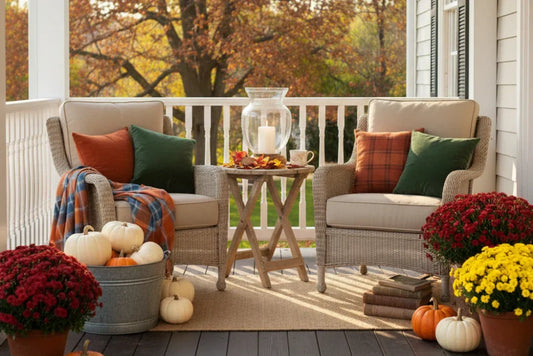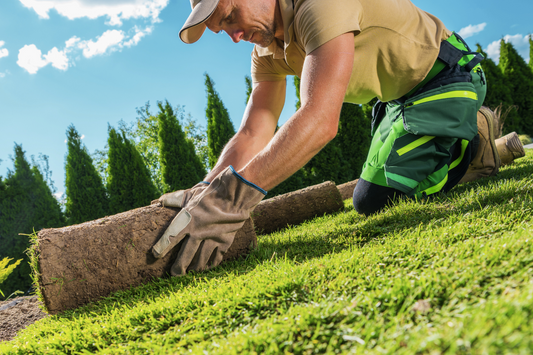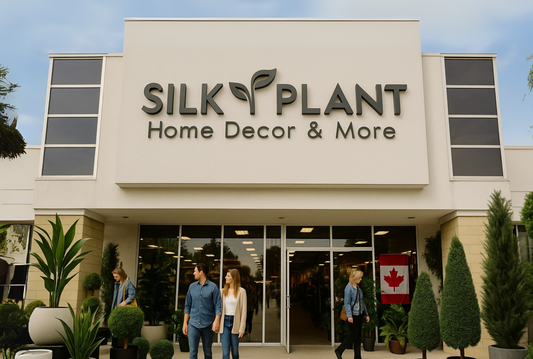
Are Artificial Plants Toxic to Children and Pets?
Artificial plants have become a stylish staple in many modern homes. From sleek urban condos to cozy downtown lofts, it's hard to ignore the popularity of artificial plants. Their maintenance-free charm, year-round colour, and photo-ready appearance make them a tempting choice—especially when life gets busy.
But as more people bring faux greenery indoors, an important question arises: Are artificial plants toxic to children and pets?
Let's take a closer look at the truth about artificial plants, the materials they’re made from, and what it means for your family’s health.
The Popularity of Artificial Plants & Greenery in Today’s Homes
There’s no denying the appeal. A good artificial plant can brighten a room instantly, add a touch of calm, and soften harsh corners without requiring sunlight or watering. For condo dwellers with limited natural light—or anyone who’s just not a plant person—faux foliage can offer the beauty of nature without the work.
Add in the fact that real plants can be tricky (and sometimes toxic) for pets, and it’s easy to see why so many turn to artificial options.
But what’s often less talked about is the toxicity of artificial plants—and whether these beautiful pieces are as safe as they are convenient.
What Artificial Plants Are Made Of
The truth about artificial plants starts with what they’re made of.
Most fake plants are created using plastic, polyester, dyes, glues, and sometimes wire or foam. Some are coated to resist UV fading or to better mimic the soft, velvety feel of real leaves. While high-quality artificial plants are typically made to last and look natural, lower-quality versions may use cheaper materials that pose more risk.
The issue isn’t necessarily the fact that they’re artificial—it’s what those artificial materials contain.
Many artificial plants made overseas (especially low-cost options) have been found to include volatile organic compounds (VOCs) and toxic chemicals like lead, cadmium, and phthalates.
Volatile Organic Compounds (VOCs), Toxic Chemicals, and Air Quality
Volatile organic compounds, or VOCs, are chemicals that can release harmful fumes into the air, especially in enclosed indoor spaces. These may come from synthetic materials, glues, or dyes used during manufacturing.

Common VOCs include:
- Formaldehyde
- Benzene
- Toluene
Over time, VOCs can impact indoor air quality and have been linked to respiratory issues, headaches, and other health risks—particularly for children and pets who are closer to the floor and may be more sensitive to these compounds.
Low-quality artificial houseplants are more likely to emit these harmful substances, especially when they’re new or exposed to heat.
Are Artificial Plants Toxic to Children and Pets?
Here’s where things get real.
Children and pets are naturally curious. They touch, grab, chew, and explore with all their senses. That makes it crucial to know whether your artificial plant could pose a danger.
 While not all artificial plants are harmful, some may contain materials that are toxic to children and pets if ingested or touched frequently. These include:
While not all artificial plants are harmful, some may contain materials that are toxic to children and pets if ingested or touched frequently. These include:
- Lead (used in dyes or as a stabilizer in plastics)
- Phthalates (plastic softeners that can disrupt hormones)
- Flame retardants (sometimes added to faux greenery)
In rare cases, ingestion of these chemicals can lead to symptoms like nausea, vomiting, skin irritation, or even a trip to the vet.
That said, not all artificial plants are toxic. Many modern faux plants are made with non-toxic materials and meet safety and quality standards—especially those marketed for indoor use in homes with kids or animals.
Real Plants vs. Faux Plants
It’s worth noting that many real plants are also toxic to pets and children. Common houseplants like lilies, pothos, and philodendron can be harmful when chewed or ingested.
 In that sense, faux plants may actually be safer than some real ones, as long as they’re made with non-toxic materials.
In that sense, faux plants may actually be safer than some real ones, as long as they’re made with non-toxic materials.
Still, it’s essential to read product labels, purchase from reputable brands, and avoid unknown or unlabeled items that might contain harmful chemicals.
How to Choose Safe Artificial Plants
The good news? Not all faux plants are created equal.
If you’re looking to decorate safely, here are a few tips to help you choose safe artificial plants:
- Look for labels like “non-toxic,” “BPA-free,” “lead-free,” or “phthalate-free.”
- Buy from trusted retailers that specialize in premium or designer artificial plants.
- Avoid very cheap imports, especially those with strong chemical smells.
- Opt for fabric-based plants with minimal glue or plastic if you're concerned about off-gassing.
- Keep faux plants out of reach of curious little hands and paws whenever possible.
What Is the Toxic Ten?
You may have heard of the "Toxic Ten"—a list of harmful chemicals often found in synthetic consumer products.

Some artificial plants made with low-grade materials may contain one or more of these:
- Lead
- Cadmium
- Phthalates
- Formaldehyde
- Benzene
- Flame retardants
- Toluene
- Styrene
- Polyvinyl chloride (PVC)
- Arsenic (less common, but possible in dyes or pigments)
While many of these substances are tightly regulated in Canada, imported or unlabeled items may still slip through. That’s why it’s smart to choose non-toxic faux greenery from trusted sources.
The Truth About Artificial Plants and Health Risks
The toxicity of artificial plants depends heavily on the materials used and how the plant was made.
While high-quality artificial plants are generally safe, some fake plants may pose risks especially for babies who mouth everything or pets who love to chew.
Potential health risks include:
- Skin irritation from contact with certain dyes
- Respiratory issues from VOCs
- Digestive issues if pieces are swallowed
That’s why safe artificial plants are a must for family-friendly homes.
Introducing Silk Plant’s Non-Toxic Artificial Greenery
At Silk Plant Decor & More, we believe that beautiful design should never come at the cost of safety. That’s why we proudly offer a curated collection of non-toxic faux plants and artificial flowers made with your home, your health, and your peace of mind in mind.

Each artificial plant we carry is crafted from premium materials that meet or exceed Canadian safety and quality standards. We avoid the harsh chemicals often found in low-quality artificial plants, and instead focus on sourcing designer plants that are free from harmful substances like lead, phthalates, and formaldehyde.
Whether you're decorating a cozy condo, a sunlit kitchen, or a pet-friendly living space, our high-quality artificial plants are designed to mimic the appearance of real plants without the added worry. No need to stress about VOCs or toxic fumes—our artificial foliage is made to look good and feel good in your space.
Because when it comes to children or pets, there's no room for compromise. Our products are not just stylish—they're thoughtful, too. So you can bring home the benefits of artificial greenery with the same confidence you'd have with the real thing.
Are Fake Plants Better Than Real Plants?
This is a bit of a trick question.
Faux greenery isn’t better than real plants, but it does offer different advantages. A good artificial plant can be ideal for:
- Low-light condos
- Busy households
- Allergy-sensitive family members
- Spaces where real plants won’t thrive
Meanwhile, real plants provide oxygen, purify the air, and can boost mental well-being.
Ultimately, many people choose to mix both—using artificial flowers for pops of color, and real greenery for air-purifying benefits. It doesn’t have to be either-or.
Eco-Friendly and High-Quality Artificial Options
Worried about the impact on the environment?
It’s true that artificial plants are made from synthetic materials, and many end up in landfills if they’re not chosen with care. But a high-quality artificial plant can last for years—sometimes decades—with minimal upkeep.
Look for plants made from recyclable or biodegradable materials, and take good care of your faux foliage to extend its life. Some companies even offer recyclable or upcyclable plant bases.
Decorating Safely with Artificial Houseplants
Artificial plants offer an easy, stylish way to bring greenery into your space. Whether you’re styling a high-rise balcony or freshening up a hallway shelf, faux foliage can be a wonderful part of your home’s look.
 But when kids or pets are involved, safety comes first.
But when kids or pets are involved, safety comes first.
To recap:
- Not all artificial plants are toxic—but some may contain harmful substances.
- Look for non-toxic artificial options from trusted brands.
- Consider mixing artificial and real plants (pet-safe varieties!) for beauty and balance.
When chosen carefully, an artificial plant can be a safe, beautiful, and lasting part of your décor.
Your home should be a haven—for you, your children, and your furry friends. With the right information, it absolutely can be.



